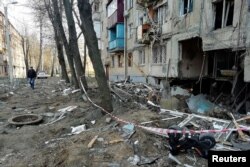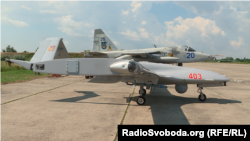With the war in Ukraine in its seventh week and Moscow pressing its campaign more forcefully in the east and south, fighting could become more brutal as the guerrilla-style tactics Ukrainians used around Kyiv to repel Russian forces shift to a more conventional battle of military might.
The Kremlin's calculus also appears to be shifting.
Having fully withdrawn from the Kyiv region, Moscow is hoping to salvage its campaign by focusing on the Donbas, where war has raged since 2014 following Russian President Vladimir Putin’s illegal annexation of Crimea and moves by Russia-backed separatists to seize territory.
Ukrainian President Volodymyr Zelenskiy said on April 9 that a “difficult battle” lies ahead in the east and that Russia was massing troops and equipment for a major offensive.
The prospect of the bloodiest fight so far in the war also comes as the unprecedented sanctions placed on Russia by Western nations are failing to halt its military campaign.
With no indications that financial leverage is slowing the Russian war effort, Western governments are now increasing the supply of heavy weaponry to Ukraine as it prepares for fighting that Ukrainian Foreign Minister Dmytro Kuleba said would more closely resemble battles from World War II, with thousands of tanks, aircraft, and armored vehicles involved.
RFE/RL spoke with Lawrence Freedman, emeritus professor of war studies at King's College London and author of The Future Of War, to get a better understanding of what this new stage of the conflict will look like.
RFE/RL: We are now seeing the Russians concentrating their campaign in the east and south. Should we expect to see a Russian military encountering similar supply and logistical issues as it did elsewhere in Ukraine? How might this phase of the war be different than the first?
Lawrence Freedman: Well, [the Russians] shouldn't have the same sort of issues as they did in the rest of Ukraine because they are able to supply from Russia through the [separatist] enclaves or through Crimea. The distances are obviously not so great for them. However, so long as they're on the offensive, they will face issues.
There's an assumption that they wish to encircle the big number of Ukrainian troops in the Donbas area, but while [Russia is] on the offensive I think they're going to have similar problems of vulnerability to the high-tech guerrilla tactics [that] the Ukrainians have been adopting, [which is] basically picking off tanks and supply lines with anti-tank weapons and drones.
[But] as soon as you start to move to more of a heavy offensive, then it becomes a very different sort of war. I expect much more artillery [to be involved], which is why I think [Kyiv] is hoping to get more of that from NATO. [This could make the war] possibly more attritional. It's obviously already been attritional [for] the Ukrainian people and [military].
You shouldn't understate the Ukrainian losses [so far]. We actually don't know as much about them as we know about Russian losses [and] this could become an [even more] brutal war in the coming days and weeks.
As with almost anything about this war, one also always has to qualify [that it] has been full of surprises and that [events] can take strange turns and armies -- even one that was quite disciplined in their own way [previously], like Russia’s -- can be quite brittle and can break if the pressure becomes too much.
So, I think the best assumption is that we're in for an [initial] stage where Russia tries to consolidate its position. If it fails to do that, then the Ukrainians will go on the offensive sooner [than expected]. Either way, they'll have to go on the offensive [at some point] and then that will be a tougher and harder campaign [than we’ve seen before].
RFE/RL: With that in mind, what are the major strategic choices the Russian high command and Ukrainian high command might be weighing right now, especially when we're looking at the south and the east?
Freedman: Well, I think the Russians have really got to work out how many lines of advance they still want because that's where it went wrong right from the start when they attacked on too many axes and their forces got too distributed, especially as they had to use the road network.
At the moment they seem to be pushing out in a number of areas, particularly around Kharkiv, where they've had some more success than they've had elsewhere. But they've really got to work out [whether] they are going to prioritize certain areas and really focus hard on them or are they going to keep on pushing in a number of areas with perhaps some ideas for a pincer movement and encirclement [of Ukrainian forces].
I think the more [the Russians] try to move in different areas at once, the more problems they’ll have. The Ukrainians, who have strategically been much shrewder and more careful so far, [will] also have to prioritize. The first priority is to carry on blunting Russian offensives, which I think they're largely doing at the moment, but they’ll certainly have to watch the one [happening] near Kharkiv. But also, there are opportunities that are opening up to encircle some Russian forces and that will be tempting and, in some cases, the temptation is worth following.
RFE/RL: Do you see a chance of following what look like opportunities and being led into blunders? Is there real risk of chasing what looks an attractive attack and getting bogged down?
Freedman: There is a risk, but so far we have to say that the Ukrainian high command has played this very well.
I think the biggest problem they will have is something you can see in most wars where one side appears to have lost in a particular battle, [which is] that you've always got to keep your eye on the artillery. The sort of things you can do with drones and anti-tank weapons can be impressive enough, but at some point you're going to need the heavier guns and the Russians have got them.
So I think that's going to be one focus of the fighting from now on.
RFE/RL: Given that Ukraine may be outgunned in that respect, how decisive could Western arm shipments be in tilting the scales more in Ukraine’s favor?
Freedman: Quite properly, the NATO countries are not talking too much about what [weapons] they're delivering -- or when and where -- but they did say that they understood the need for heavier weapons.
We’re seeing tanks coming from the Czechs and the British are providing harpoon anti-ship missiles, which could actually be quite a big deal if they use them and start to sink major Russian vessels. Depending on the numbers and depending on how they get there, and that they're not interrupted by Russian interdiction, this will make a difference.
But this is a very greedy war in terms of equipment and material. Both sides are going to need supplies to be coming in all the time and I'm just not sure what the situation is on the Russian side.
We've tended to talk about their logistical problems more in terms of actually getting the stuff to the front, but it’s clear there are [supply] shortages too. There's talk of them running out of smart bombs -- precision guided weapons -- for their aircraft, which is one reason that their air force hasn't been as effective as it [was] expected [to be] in supporting the army. So, shortages do have an effect and both sides have to pace themselves to a degree with that in mind.
RFE/RL: Do you think that we have any clarity about what an endgame might look like for the Kremlin, especially given that U.S. intelligence officials have said that Putin wants to have some sort of success to sell the public for the Victory Day parade on May 9?
Freedman: I think not having something by May 9 would be embarrassing for Putin, but I don't think that it will be decisive. Whatever the situation becomes, they’ll deal with it, but [May 9] is a factor in their calculations.
If the Russians declare some sort of cease-fire, the Ukrainians may accept a truce for a while, but they don't have to stop their military preparations and so on and so forth. It seems to me there's a lot of risk with cease-fires that don't actually stabilize the situation and that's something the Russians could try even if they feel that they're being pushed back. They may try it just because it’s better to stick with what they've got than to wait a bit and have even less.
I think it's very difficult to know what the Russians want, to be honest. Donetsk and Luhansk in their classical borders? Yes, I suppose that could be it. Something that stretches from Kharkiv to Odesa? Well, they might have liked that, but I think that would be extremely hard to achieve now.
To me, there's always been this question of what does [the Kremlin] actually think they're going to do with this territory now? They've battered it and pummeled it, they've murdered [civilians] within it, whatever assumptions they may have had about this being a Russophile part of Ukraine, it isn’t anymore.
So, what actually is the plan? Do they really intend to annex an area [in defiance of] the international community in ways that would ensure that the war continued in one way or another [and] that sanctions stayed in place? Even if they could get Zelenskiy to agree to that, which I doubt, that doesn’t necessarily settle anything.
There are some suggestions that what [Putin] is trying to do now is take out as much infrastructure and civil society as [possible] and that he has this view that if [he] can't have Ukraine, then Ukrainians can’t have it either. That’s [the only explanation] that adds up because otherwise the way this war is being conducted is grotesquely at odds with what the [Kremlin] says its objectives are.











